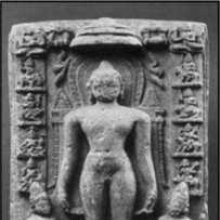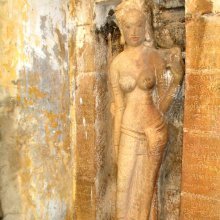Indian Art: 4 definitions
Introduction:
Indian Art means something in Hinduism, Sanskrit, the history of ancient India. If you want to know the exact meaning, history, etymology or English translation of this term then check out the descriptions on this page. Add your comment or reference to a book if you want to contribute to this summary article.
Images (photo gallery)
In Hinduism
Shilpashastra (iconography)
Source: Shodhganga: The significance of the mūla-beras (śilpa)Art is the expression of a dominant idea in a beautiful form. The temple arts aim at the transcendental union of jivātma or individual soul with the Supreme Soul, Paramātman. In India, art and religion are intimately interrelated. The art of dance occupies a significant place in Indian culture. Dance in India is considered divine in origin. Indian dance includes tribal, folk and classical forms. The common root of all the classical dance forms can be traced to Bharata’s Nāṭyaśāstra, a comprehensive work on the science and technique of Indian drama, dance, and music. Among the classical dances that are prevalent in India, Bharatanatyam occupies an important position, and it is believed to have originated in Tamilnadu.

Shilpashastra (शिल्पशास्त्र, śilpaśāstra) represents the ancient Indian science (shastra) of creative arts (shilpa) such as sculpture, iconography and painting. Closely related to Vastushastra (architecture), they often share the same literature.
India history and geography
Source: archive.org: Bharatiya vastu-sastra (History)Indian Art.—Modern writers begin the history of Indian art from the Mauryan period. But the recent discoveries and other evidences have rightly influenced writers like Dr. Fabri (a Hungarian scholar) to divide Art Movements in India in three chronological zones, 1st about 2600 B.C. when one encounters Indian Art during the period of Mohenjodaro and Harappa, 2nd 1800 B.C., nothing is known of the period between 2600 and 1800 B.C. , owing to thousands of unexplored sites in Sind and Baluchistan, and the 3rd period beginning from 1800 B.C. starts the Aryan period and from 300 B.C. starts the period of Asoka when Indian art manifests itself at its highest form of expression.
Arts and crafts, pleasures and pastimes arc best suited to an advanced corporate life where different professionals of art cater to the needs of citizens of rank. Royal courts and palaces have been equally rather more significant to patronise these artists and encourage them for better efforts and nobler creations. This is what Vātsyāyana teaches us in his Kāmasūtra. The traditional sixty-four arts, their rise and cultivation could be possible only in such an environment where youth and beauty have their full play.
Source: Ramakrishna Math: The Representation of nature in early Indian narrative art of BharhutIndian art besides documenting the history of a magnificent civilisation opens a relatively simple yet fascinating path into the timeless realm of the Indian spirit by rendering in eloquent visual forms the whole message that India holds in keep for humanity. Indian art is not concerned with the conscious striving after beauty as a thing worthy to be sought after for its own sake, its main endeavour is always directed towards the realization of an idea, reaching through the finite to the infinite, convinced always that through the constant effort to express the divine origin of all earthly beauty the human mind will take in more and more of the perfect beauty of divinity.
Nature, the inherent spirit of Indian art has found its expression in rhythmical order and discipline from early times. Indian art relies on the myths and beliefs of its people. With deep and sacred meanings, plant and animal metaphors, a necessary attribute of the archetypical locus amoenus in all cultures, are important elements in the traditions and beliefs of India, including that of the followers of Buddhism in the ancient times.
Source: Shodhganga: Elements of Art and Architecture in the Trtiyakhanda of the Visnudharmottarapurana (history)The history of Indian Art covers approximately five thousand years which presents a rich and almost continuous record. The story of Art flourishes in the Indus Valley, in the third millennium B.C. This idea has been revealed by the remains of highly developed civilization in the Punjab and Sindh. With the expansion of the Aryan territory from the Indus to the Ganges, Art and culture got an upward turn in the whole land. Aryan people were completely familiar with the Arts of dancing, singing, weaving, building, making ornaments of gold and silver and the like.
Indian Art and Architecture are very much influenced by the works of Sanskrit literature. Many treatises of Sanskrit literature talk about different art forms like Dance, Drama, Music, Painting etc., and it is seen that sometimes the discussions are on the technical aspects of these art forms and sometimes these are on general contents.

The history of India traces the identification of countries, villages, towns and other regions of India, as well as mythology, zoology, royal dynasties, rulers, tribes, local festivities and traditions and regional languages. Ancient India enjoyed religious freedom and encourages the path of Dharma, a concept common to Buddhism, Hinduism, and Jainism.
See also (Relevant definitions)
Full-text (+367): Gupta, Thanjavur, Cola, Shunga, Hoyasala, Yadava, Rashtrakuta, Sadrishya, Pala, Sena, Maurya, Satavahana, Bhava, Pallava, Pramana, Lavanyayojana, Calukya, Kushana, Varnikabhanga, Rupabheda.
Relevant text
Search found 40 books and stories containing Indian Art; (plurals include: Indian Arts). You can also click to the full overview containing English textual excerpts. Below are direct links for the most relevant articles:
Ananda Coomaraswamy and Indian Cultural Resurgence < [April – June, 1987]
Sri Aurobindo on Art < [July – September 1972]
Coomaraswamy, Ananda Kentish < [July – September 1977]
Vishnudharmottara Purana (Art and Architecture) (by Bhagyashree Sarma)
4. A General Note on Architecture < [Chapter 1 - Introduction]
5. The Viṣṇudharmottara-purāṇa and the Modern Paintings < [Chapter 6 - Modern Relevance of Different Art Forms and Architecture]
3. A General Note on Art < [Chapter 1 - Introduction]
Pallava period (Social and Cultural History) (by S. Krishnamurthy)
Introduction to Art < [Chapter 2 - Origin of Sculptural Art—Its Development and Scheme]
Origin of Sculptural Art (a): Pre And Proto-Historic Period < [Chapter 2 - Origin of Sculptural Art—Its Development and Scheme]
Vaikakshaka or Chhannavira < [Chapter 4 - Material Culture of the People]
Jain Remains of Ancient Bengal (by Shubha Majumder)
Museum Collections or Recovered from Ponds < [Chapter 5 - Jaina Architectural and Sculptural Remains]
Archaeological sites in Dolgaon (Dakshin Dinajpur District) < [Chapter 4 - Distribution of Sites Yielding Jaina Remains]
Archaeological sites in Rajsahi (Rajsahi Division, Bangladesh) < [Chapter 4 - Distribution of Sites Yielding Jaina Remains]
Vastu-shastra (1): Canons of Architecture (by D. N. Shukla)
(vi) Rise of Art < [Chapter 4 - An outline History of Hindu Architecture]
(i) Origin of Indian architecture < [Chapter 4 - An outline History of Hindu Architecture]
(ii) Subject-matter of Architecture (Vāstu) < [Chapter 2 - Scope and Subject-matter]
Jainism in Odisha (Orissa) (by Ashis Ranjan Sahoo)
Jain Art in Odisha (Introduction) < [Chapter 5]
Jaina Metal images from Kakatpur < [Chapter 3: Survey of Jaina Antiquities in Odisha]
Jain Architecture (Introduction) < [Chapter 4]
Related products




